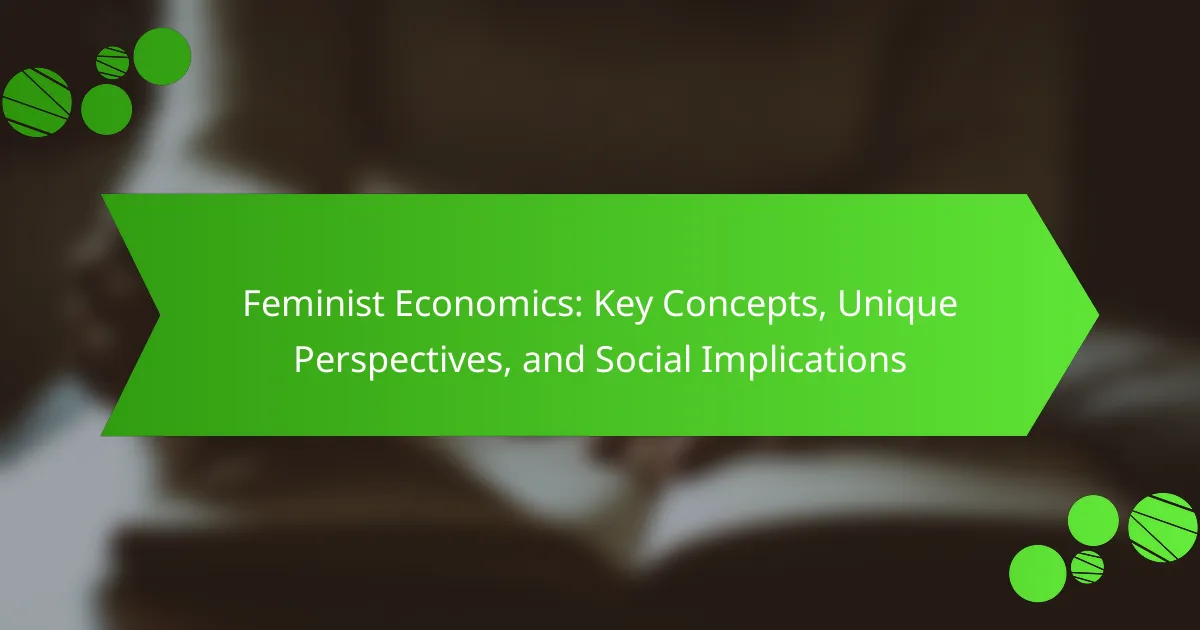Development economics is a specialized field that analyzes the economic dimensions of development in low-income countries, focusing on how to achieve and sustain economic growth. It investigates the influence of institutions, policies, and social factors on economic outcomes, addressing critical issues such as poverty, inequality, and unemployment. The article examines key theories, including structural change, human capital, and sustainable development, while highlighting empirical indicators like GDP growth and literacy rates for measuring progress. Additionally, it discusses the significance of effective policies in shaping development, the challenges posed by income inequality, unemployment, and climate change, and the necessity for innovative policy solutions and international collaboration to foster sustainable economic development.

What is Development Economics?
Development economics is a branch of economics that focuses on the economic aspects of the development process in low-income countries. It examines how economic growth and development can be achieved and sustained. Development economics emphasizes the role of institutions, policies, and social factors in shaping economic outcomes. This field analyzes issues such as poverty, inequality, and unemployment. It also explores the impact of international trade and foreign aid on development. Key theories include structural change, human capital, and sustainable development. Empirical research often utilizes indicators like GDP growth, literacy rates, and health outcomes to measure progress.
How does Development Economics differ from traditional economics?
Development economics focuses on improving the economic conditions of developing countries. Traditional economics often emphasizes market efficiency and resource allocation in developed economies. Development economics addresses issues like poverty, inequality, and social welfare, which are less emphasized in traditional economics. It incorporates interdisciplinary approaches, including sociology and political science, to understand economic development. Traditional economics typically relies on quantitative models and assumes rational behavior. In contrast, development economics often considers qualitative factors and local contexts. This distinction highlights the unique challenges faced by developing nations compared to the established frameworks of traditional economics.
What are the key objectives of Development Economics?
The key objectives of Development Economics are to analyze and promote economic growth and development in low-income countries. This field aims to understand the factors that contribute to economic disparities. It also seeks to formulate policies that enhance living standards and reduce poverty. Development Economics investigates the role of institutions in economic performance. Additionally, it emphasizes sustainable development and environmental considerations. The field uses empirical data to assess the effectiveness of various development strategies. Overall, it strives to create equitable opportunities for all members of society.
Why is Development Economics important for global progress?
Development economics is crucial for global progress as it addresses the economic challenges faced by developing nations. It provides insights into poverty alleviation, income inequality, and sustainable growth. By analyzing various economic models, policymakers can implement effective strategies. For instance, the World Bank reports that targeted development programs can reduce extreme poverty by up to 30% in a decade. Additionally, development economics emphasizes the importance of education and health in economic growth. It highlights that investing in human capital leads to increased productivity. Furthermore, understanding global trade dynamics is essential for developing countries to compete effectively. Overall, development economics serves as a framework for creating policies that foster economic stability and growth worldwide.
What are the main theories in Development Economics?
The main theories in Development Economics include the Classical Theory, Structural Change Theory, and Dependency Theory. The Classical Theory emphasizes free markets and the role of capital accumulation in growth. Structural Change Theory focuses on the transformation of an economy from agriculture to industry. Dependency Theory critiques the global economic system, arguing that resources flow from periphery to core nations, perpetuating inequality.
Additionally, the Neoclassical Growth Theory highlights the importance of technological progress and human capital. The New Institutional Economics examines the role of institutions in economic performance. Each theory provides distinct perspectives on the mechanisms of economic development and the challenges faced by developing nations.
How do classical theories explain economic development?
Classical theories explain economic development through the lens of factors such as labor, capital, and land. These theories emphasize the role of production and the accumulation of resources. Adam Smith, a key figure, argued that economic growth arises from specialization and division of labor. This leads to increased productivity and efficiency. David Ricardo introduced the concept of comparative advantage, highlighting how trade can enhance economic development. He noted that countries should specialize in producing goods where they hold a relative efficiency. John Stuart Mill expanded on these ideas, emphasizing the importance of capital investment in driving growth. Classical economists believed that free markets and competition foster innovation and efficiency. Historical evidence supports these theories, as many economies have grown through industrialization and trade based on these principles.
What role do modern theories play in understanding development?
Modern theories play a crucial role in understanding development by providing frameworks for analysis and policy formulation. They help identify the factors influencing economic growth and social progress. For instance, theories like endogenous growth theory emphasize the importance of knowledge and innovation in driving development. They also highlight the role of human capital and institutions. Modern theories offer insights into the complexities of global inequality and poverty. Empirical studies support these theories, demonstrating their relevance in real-world scenarios. For example, the World Bank’s findings illustrate how investment in education boosts economic outcomes. Overall, modern theories are essential for effective development strategies and interventions.
What measurement indicators are used in Development Economics?
Measurement indicators used in Development Economics include Gross Domestic Product (GDP), Human Development Index (HDI), and Gini coefficient. GDP measures the economic output of a country. HDI combines life expectancy, education, and per capita income indicators. The Gini coefficient assesses income inequality within a population. Other indicators include poverty rates, literacy rates, and employment rates. These metrics help evaluate economic progress and social well-being. Each indicator provides insights into different aspects of development. For example, GDP reflects economic growth, while HDI offers a broader view of human welfare.
How are economic growth and development measured?
Economic growth is primarily measured by the increase in a country’s Gross Domestic Product (GDP). GDP quantifies the total value of all goods and services produced over a specific time period. Economic development, on the other hand, encompasses broader indicators, including improvements in living standards, education, and health. These are often assessed through Human Development Index (HDI) metrics, which combine life expectancy, education level, and income.
Additional measures for economic growth include Gross National Product (GNP) and per capita income. GNP accounts for the value produced by a nation’s residents, regardless of location. Per capita income provides insight into the average income earned per person, indicating economic well-being.
For economic development, social indicators such as literacy rates, poverty rates, and access to healthcare are crucial. These indicators reflect the quality of life and equitable distribution of resources. Countries often use a combination of these metrics to assess their economic performance comprehensively.
What are the limitations of current measurement indicators?
Current measurement indicators have several limitations. They often fail to capture the full complexity of economic development. Many indicators rely heavily on quantitative data, overlooking qualitative aspects. This can lead to an incomplete understanding of development outcomes. Additionally, some indicators may be outdated or not relevant to current contexts. They may not account for regional differences or local conditions. Furthermore, reliance on a limited set of indicators can skew policy decisions. This can result in ineffective or misdirected development strategies. Overall, these limitations can hinder accurate assessments and appropriate responses in development economics.

How do policies influence Development Economics?
Policies shape Development Economics by determining the frameworks within which economic growth occurs. They influence resource allocation, investment priorities, and regulatory environments. For example, government policies can promote education and health, leading to a more skilled workforce. This workforce can drive economic productivity and innovation. Furthermore, trade policies impact international market access, affecting local economies. Evidence shows that countries with favorable trade policies experience higher growth rates. A study by the World Bank found that trade liberalization increased GDP growth in developing nations by an average of 1.5% annually. Thus, effective policies are crucial for fostering sustainable economic development.
What are the key policy recommendations in Development Economics?
Key policy recommendations in Development Economics include promoting inclusive economic growth, investing in education, and enhancing infrastructure. Inclusive growth ensures that economic benefits reach all segments of society. Education investment boosts human capital, leading to higher productivity. Improved infrastructure, such as transportation and energy, facilitates trade and access to markets. Additionally, policies should focus on strengthening institutions to foster governance and reduce corruption. Social safety nets are essential to protect the vulnerable during economic transitions. Lastly, promoting sustainable practices addresses environmental concerns while supporting economic development. These recommendations are supported by various studies showing their impact on economic outcomes.
How do trade policies affect economic development?
Trade policies significantly influence economic development by affecting trade flows, investment, and domestic industries. These policies can either promote or hinder exports and imports. For instance, protective tariffs can shield local industries but may lead to retaliation and decreased trade. Conversely, free trade agreements can enhance market access and stimulate economic growth. Research by the World Bank indicates that countries with open trade policies typically experience higher GDP growth rates. Additionally, trade policies can impact job creation and innovation by shaping competitive environments. Thus, the formulation of trade policies is crucial for fostering sustainable economic development.
What role does education policy play in economic growth?
Education policy is crucial for economic growth. It shapes the quality and accessibility of education. Effective education policies increase human capital. A well-educated workforce drives innovation and productivity. Countries with strong education systems often experience higher GDP growth rates. For instance, the World Bank reports that each additional year of schooling can increase a person’s earnings by up to 10%. Additionally, education policies that focus on STEM fields can lead to technological advancements. These advancements contribute to economic diversification and resilience. Thus, education policy plays a vital role in fostering sustainable economic development.
How can governments implement effective development policies?
Governments can implement effective development policies by establishing clear objectives and measurable outcomes. They should engage stakeholders to gather diverse perspectives and ensure inclusivity. Data-driven decision-making is crucial; governments must analyze economic indicators to inform policies. Regular monitoring and evaluation of policy impacts help in adjusting strategies as needed. Collaboration with international organizations can provide additional expertise and resources. Transparency in governance fosters trust and encourages public participation. For example, countries like South Korea have successfully used targeted investments in education and technology to drive economic growth. These approaches demonstrate that strategic planning and evidence-based practices lead to successful development outcomes.
What strategies can be used to assess policy effectiveness?
Strategies to assess policy effectiveness include quantitative analysis, qualitative assessments, and stakeholder feedback. Quantitative analysis involves measuring specific indicators before and after policy implementation. For example, economic growth rates or employment figures can indicate the impact of a policy. Qualitative assessments focus on gathering insights through interviews or case studies. This approach provides context and understanding of the policy’s effects. Stakeholder feedback is crucial, as it captures the experiences and opinions of those affected by the policy. Engaging with communities can reveal unintended consequences and areas for improvement. These strategies, when combined, offer a comprehensive view of policy effectiveness.
How can stakeholder engagement improve policy outcomes?
Stakeholder engagement can improve policy outcomes by ensuring diverse perspectives are considered. Involving stakeholders leads to more informed decision-making. Engaged stakeholders often provide valuable insights that enhance policy relevance. This process can increase public trust and support for policies. Research shows that policies developed with stakeholder input have higher implementation success rates. For instance, a study by the World Bank found that community involvement in policy design leads to better alignment with local needs. Engaging stakeholders also fosters collaboration, which can result in shared ownership of policy initiatives. Ultimately, effective stakeholder engagement contributes to more sustainable and effective policy outcomes.

What are the challenges in Development Economics today?
The challenges in Development Economics today include income inequality, unemployment, and climate change. Income inequality persists as a significant barrier to economic growth. According to the World Bank, the richest 10% of the population in many countries earn significantly more than the poorest 50%. Unemployment rates remain high in developing countries, particularly among youth. The International Labour Organization reported that global youth unemployment reached 14% in 2021. Climate change poses a growing threat to economic stability. Natural disasters disrupt livelihoods and exacerbate poverty. Additionally, access to education and healthcare remains unequal, hindering human capital development. These challenges require innovative policy solutions and international cooperation to address effectively.
How do global crises impact Development Economics?
Global crises significantly impact Development Economics by altering economic stability and growth trajectories. These crises can include financial downturns, pandemics, or geopolitical conflicts. They often lead to increased poverty and inequality, as vulnerable populations are disproportionately affected. For example, the COVID-19 pandemic caused a sharp decline in global GDP, with estimates suggesting a contraction of 3.5% in 2020.
Additionally, global crises disrupt trade and investment flows, which are critical for developing economies. A study by the World Bank indicated that developing countries faced a 20% drop in foreign direct investment during the pandemic. Furthermore, crises can shift government priorities, leading to changes in policy frameworks and resource allocation. This can hinder long-term development goals, as immediate needs often take precedence.
In summary, global crises reshape the landscape of Development Economics by exacerbating existing challenges and creating new obstacles for economic progress.
What are the effects of climate change on economic development?
Climate change negatively impacts economic development through various mechanisms. It leads to increased frequency and severity of natural disasters. These disasters can disrupt infrastructure and reduce productivity. Agriculture suffers due to changing weather patterns, affecting food security. Water scarcity becomes more prevalent, impacting both industry and households. Health issues related to climate change can reduce labor force participation. Additionally, climate change can exacerbate poverty levels, particularly in vulnerable regions. According to the Intergovernmental Panel on Climate Change, global economic losses could reach trillions of dollars by 2050 if no action is taken.
How does inequality affect development outcomes?
Inequality negatively affects development outcomes by limiting access to resources and opportunities. High levels of inequality can lead to lower economic growth. For instance, countries with greater income disparity often experience reduced social mobility. This results in a lack of investment in education and health for disadvantaged groups. According to the World Bank, inequality can reduce GDP growth by 1.5 percentage points annually in developing countries. Furthermore, inequality can exacerbate social tensions and conflict, hindering development efforts. Overall, addressing inequality is essential for sustainable economic development.
What best practices can enhance Development Economics initiatives?
Best practices that can enhance Development Economics initiatives include stakeholder engagement, data-driven decision-making, and adaptive management. Stakeholder engagement ensures that the needs and perspectives of local communities are incorporated into development projects. Research shows that projects with strong community involvement have a higher success rate, as they align with local priorities.
Data-driven decision-making relies on accurate and timely data to inform policies and interventions. The World Bank emphasizes the importance of using robust data analytics to assess economic conditions and outcomes. This approach leads to more effective resource allocation and targeted interventions.
Adaptive management allows for flexibility in project implementation. This practice enables initiatives to respond to changing circumstances and feedback from beneficiaries. Studies indicate that adaptive management improves project resilience and sustainability.
Lastly, capacity building within local institutions strengthens the effectiveness of development initiatives. By investing in local skills and knowledge, projects can achieve greater long-term impact and sustainability. Evidence from various development programs supports this approach, demonstrating improved outcomes when local capacities are enhanced.
How can data-driven approaches improve development strategies?
Data-driven approaches can significantly enhance development strategies by providing empirical evidence for decision-making. These approaches utilize quantitative data to identify trends and measure outcomes effectively. For instance, data analytics can reveal the most effective interventions in health or education sectors. This targeted information allows policymakers to allocate resources more efficiently. Furthermore, data-driven methods can track the progress of development initiatives over time. By analyzing performance metrics, stakeholders can adjust strategies based on real-time feedback. Studies have shown that countries employing data-driven policies see improved economic outcomes. For example, the World Bank reported that data-informed decisions lead to a 20% increase in project success rates. Thus, integrating data into development strategies fosters accountability and enhances overall effectiveness.
What role does innovation play in fostering economic growth?
Innovation drives economic growth by enhancing productivity and creating new markets. It introduces new technologies and processes that improve efficiency. For example, the introduction of the internet revolutionized communication and commerce. According to a report by the McKinsey Global Institute, digital innovation could contribute $2.2 trillion to the global economy by 2025. Additionally, innovation fosters competition, leading to better products and services. This competition can stimulate job creation and investment. Studies show that countries with higher innovation rates tend to have stronger economic performance. Thus, innovation is a crucial engine for sustainable economic growth.
Development Economics is a specialized branch of economics that focuses on the economic processes and challenges faced by low-income countries, emphasizing the roles of institutions, policies, and social factors in achieving sustainable growth. The article outlines key theories, such as Classical and Structural Change Theory, and discusses measurement indicators like GDP and Human Development Index (HDI) used to assess economic progress. It also highlights the importance of effective policies in addressing issues like poverty, inequality, and climate change, while providing best practices for enhancing development initiatives through stakeholder engagement and data-driven approaches. Overall, the content serves as a comprehensive overview of the critical elements shaping Development Economics today.



